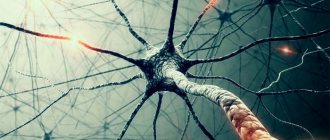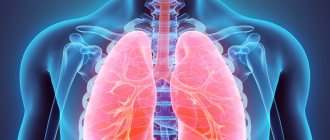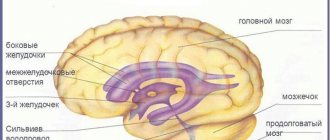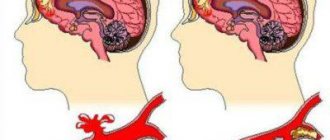Basov Pavel Igorevich
Neurologist, Reflexotherapist, Hirudotherapist. Doctor of the highest qualification category. medical experience more than 15 years.
Vascular diseases of the brain are recognized in medicine as one of the most dangerous groups of diseases, as they have quite serious consequences for the body. Each cerebral vascular disease has characteristic features that depend on which specific vessels are affected by the pathological process. But in any case, doctors at EUROMEDPRESTIGE warn that diseases in this group can provoke a hemorrhagic or ischemic stroke, after which the patient either becomes disabled or dies.
Symptoms of vascular diseases of the brain
Among the first signs of the disease are chronic headaches, memory loss, decreased hearing and vision, impaired movement, and dizziness.
Discirculatory encephalopathy, that is, a functional disorder of the brain that causes poor blood circulation, is characterized by special symptoms. In the first stages of the disease, the patient experiences emotional instability, chronic fatigue, irritation, dullness of attentiveness, headaches after overexertion (not only physical, but also mental). As a rule, symptoms are more pronounced in the evenings. In the later stages of dyscirculatory encephalopathy, the patient ceases to adequately assess his own condition, feels unsure of his abilities, and loses the ability to think in abstract concepts. At the same time, energy depletion occurs, depriving a person of the opportunity to independently cope with everyday tasks, opting for simpler actions. Hypochondria, a panicky fear of getting sick, is often noted.
| Appointment with a neurologist, therapeutic and diagnostic, outpatient | 1,800 rub. |
| Determination of the risk of stroke (risk testing, determination of functional disorders of higher brain functions) | 500 rub. |
| Therapeutic paravertebral blockade | 1,500 rub. |
| TES therapy session (1 session) | 1,100 rub. |
| Therapeutic mesotherapy (1 procedure) | 1,950 rub. |
| Appointment with a reflexologist, therapeutic and diagnostic, outpatient | 1,200 rub. |
| Superficial reflexology (1 session) | 1,000 rub. |
| View the entire price list |
Clinical manifestations of vascular diseases of the brain can be divided into the following forms:
- chronic cerebral ischemia stage I-II;
- cerebral circulatory disorder of a transient nature;
- cerebral infarction (ischemic stroke);
- bleeding in the brain (hemorrhagic stroke).
Diagnostics
Problems with the blood vessels of the head and neck can begin at any age, so everyone should know the main symptoms of the pathology. This information can subsequently help in diagnosing pathology.
Ultrasound. In this case, the standard examination procedure is ineffective, so specialists conduct the following types of examination of cerebral vessels: duplex scanning, Dopplerography, echotomography or transcranial Dopplerography. Neurosonography is performed in infants.
CT or MRI. With their help, a diagnostician can determine the area of damage to the brain substance, the size of the area of necrosis and the condition of the organ as a whole.
Angiography. Allows you to detect areas of obstructed cerebral circulation in the head, the degree and order of filling of blood vessels. Using it, you can obtain data on the presence of additional blood routes when the main arteries and veins are blocked.
Rheoencephalography. This method of studying the vascular system of the brain is based on recording the electrical resistance of nervous tissue when a weak high-frequency electric current is passed through it. After decoding, the specialist receives information about the elasticity of the walls of blood vessels, the presence of neoplasms and aneurysms.
Peripheral artery diseases
This group of pathologies is united by the fact that peripheral arteries that provide blood supply to specific organs and tissues are affected.
Among the most pressing diseases in this group:
- obliterating atherosclerosis;
- thromboangiitis obliterans;
- nonspecific aortoarteritis.
Each of them has its own characteristics.
Obliterating atherosclerosis is a chronic and steadily progressing disease, which is based on severe disorders of lipid metabolism. Clinical manifestations vary widely, depending on which segment of the arterial bed is affected by the process.
In the context of peripheral vascular damage, let us consider the main symptoms of obliterating atherosclerosis of the arteries of the lower extremities:
while walking, sharp pains of significant intensity occur, which force a person to stop (the phenomenon of intermittent claudication);
- the trophism of the soft tissues of the lower extremities is disrupted, which is manifested by dry skin, hair loss, and the gradual disappearance of the subcutaneous fat layer;
- Damage to the skin of the legs, even the smallest abrasions and wounds, heal very poorly, against which the likelihood of the formation of trophic ulcers increases.
Thromboangiitis obliterans is a disease in which obliteration (blockage) develops predominantly at the level of medium and small vessels. This disease is characterized by a triad of symptoms:
- the phenomenon of intermittent claudication, which has already been described above;
- Raynaud's syndrome, manifested by specific symptoms of the fingers and/or toes;
- the phenomenon of superficial thrombophlebitis of the veins of the lower extremities.
A disorder such as Raynaud's syndrome usually receives the most attention. Under the influence of a stress factor, the skin of the fingers becomes literally white, and a severe burning and swelling occurs in the fingers themselves. At advanced stages of the process, the fingers acquire a bluish tint, become cold and wet (all these changes are permanent).
Nonspecific aortoarteritis is an autoimmune disease, the nature of which still remains unclear. It affects large arterial trunks (aorta and its branches), causing their stenosis.
Symptoms are quite non-specific:
- general weakness and malaise;
- headache;
- increased body temperature;
- sleep disorders;
- pain in large joints;
- weight loss
All these symptoms are distinguished by the fact that the patient, as a rule, cannot understand the causes of his illness. In addition, it often happens that the disease is asymptomatic for a long time, manifesting itself with severe complications (formation of vascular aneurysms with their rupture).
Rheumatic carditis
Rheumatic carditis is a collective concept that unites many variants of damage to the heart, its valves, as well as large vessels as a result of the rheumatic process.
The most common variants of this disease are:
- rheumatic pericarditis;
- rheumatic myocarditis;
- rheumatic endocarditis.
Rheumatic carditis
The clinical symptoms of each of these diseases are similar and include:
- chronic pain in the heart that is dull in nature;
- tendency to experience shortness of breath during physical activity;
- frequent bluishness of the fingertips, nose, earlobes;
- periodically occurring wet cough;
- progressive edema of the lower extremities.
In addition, patients always complain of symptoms of rheumatic origin:
- pain in the joints, mainly small ones, characterized by an unstable, so-called “volatile” character;
- periodic increase in body temperature for no apparent reason;
- severe general weakness and malaise.
These types of cardiovascular diseases very often cause difficulties during the diagnostic search. Therefore, it is important to always remember rheumatic carditis as a possible cause of illness.
Congenital heart defects
CHD is, as a rule, a hereditary anomaly, which is a gross defect in the structure of an organ. Among the most common congenital diseases are:
- ventricular septal defect (VSD);
- atrial septal defect (ASD);
- unclosed duct of Botallus;
- tetralogy of Fallot;
- coarctation of the aorta.
Tetralogy of Fallot
Each such disease has its own characteristic manifestations. But it is important for parents to know the general signs of pathology that may suggest a heart problem. These include:
- change in color of the skin and/or mucous membranes with the appearance of severe pallor or cyanosis;
- the appearance of cyanosis during breastfeeding;
- lower temperature of the extremities, which is noticeable with a simple touch;
- swelling (possible both in the lower extremities and generalized).
Of course, a child with a hereditary pathology will behave poorly, he will cry a lot, eat poorly, and have problems sleeping. But all these are nonspecific manifestations of pathology, which occur in any other disease.
Complications
Complications of brain surgery associated with the use of general anesthesia are allergic reactions (urticaria, edema, anaphylactic shock), respiratory disorders (laryngospasm, bronchospasm), cardiovascular disorders up to cardiac arrest, neurological disorders (confusion, memory impairment ).
If the cranial cavity is insufficiently sealed, liquorrhea may develop. The area of the brain where surgical manipulations were performed can become a focus of epileptic activity, a site for the development of a postoperative cyst or abscess, or a zone of ischemia. We cannot exclude the possibility of postoperative neurological deficits—impaired motor function of the limbs, sensory loss, pathology of the cranial nerves, speech disorders, memory, etc.
Contraindications
Interventions on the brain are most often performed in cases of intracerebral formations of various origins (hematomas, cysts, abscesses, brain tumors) or expansion of the natural cavities of the brain as a result of impaired circulation of cerebrospinal fluid. This is due to the fact that in the limited space of the cranium, even a small new formation or a slight increase in existing brain structures leads to compression and displacement, and therefore to disruption of the functioning of healthy brain tissue.
Interventions are contraindicated in patients in a coma, in serious condition, or in the presence of decompensated chronic diseases. The reason is possible negative consequences when using anesthesia, a high risk of developing intraoperative and postoperative complications. Contraindications to surgery include infectious skin lesions at the site of the surgical incision, inflammatory diseases of the brain structures and internal organs, since in such a situation there is a high probability of infection of brain tissue.
Deep vein thrombosis and pulmonary embolism
The phenomena of thrombosis and embolism can develop in any segment of the bloodstream. In this case, deep vein thrombosis of the lower extremities and pulmonary embolism (PE) have the greatest clinical significance.
Symptoms of deep vein thrombosis in the legs are:
- severe pain in the limb;
- a pronounced feeling of heaviness, fullness, which does not give rest;
- progressive swelling;
- change in skin color.
The process, as a rule, is one-sided and the most attention is drawn to progressive edema. In this case, one limb becomes noticeably larger than the other and has an unhealthy appearance.
The main danger of such thrombosis is the extremely high probability of developing pulmonary embolism. After all, if one of the blood clots comes off, which is quite possible, it will be carried through the bloodstream into the pulmonary artery system, where it will cause a blockage.
The list of typical clinical manifestations of pulmonary embolism includes:
severe shortness of breath, difficulty breathing;
- swelling of the neck veins, which is visible visually;
- severe cyanosis of the face;
- severe pain in the chest.
Hemoptysis, low-grade fever, fainting, bradycardia, etc. are also possible. It all depends on where the blood clot will cause blockage.
Cardiac ischemia
IHD is a pathology that develops as a result of impaired blood supply to the myocardium.
This disorder can be acute or chronic. The cause of an acute disorder is usually spasm, thrombosis or thromboembolism of the coronary arteries, but a chronic one is progressive atherosclerosis of the coronary bed. Among the acute forms of IHD there are:
- sudden coronary death (SCD, also known as primary cardiac arrest);
- myocardial infarction.
Coronary heart disease
Among chronic forms:
- angina pectoris (stable, unstable, vasospastic);
- cardiosclerosis;
- painless form of ischemic heart disease.
Myocardial infarction is the most striking example of the acute course of coronary artery disease.
Clinical symptoms are:
- severe pain, which can be localized directly in the heart area or behind the sternum, radiating to the shoulder, arm, shoulder blade, neck and even lower jaw;
- pain occurs suddenly, quite often for no apparent reason, is acute, has significant intensity, and is not relieved by Nitroglycerin;
- pain is accompanied by a sharp deterioration in general well-being, severe pallor of the skin, profuse sweat, weakness;
- a person panics, a feeling of anxiety develops, a strong fear of death appears, and loss of consciousness is possible.
Myocardial infarction
The last point is a specific sign of myocardial infarction. Of course, it is also possible that a person will suddenly become lethargic and show neither excitement nor anxiety. But in such cases, only external manifestations are absent, and internal tension and fear always take place.
Angina pectoris is the most common variant of the chronic course of coronary artery disease. Patients suffering from angina pectoris have the following complaints:
decreased tolerance to physical activity, shortness of breath quickly develops;
- cardialgia (cardiac pain) occurs periodically, which have a clear connection with the causative factor, are limited in time and, as a rule, are relieved by Nitroglycerin;
- periodically there are sensations of interruptions in the work of the heart, episodes of tachy- or bradyarrhythmias.
Angina always carries an increased risk of developing myocardial infarction.
Prevention
To avoid problems with the vascular system, you must:
- walk and run more (if possible, jogging should be done daily);
- swim (swimming strengthens all muscles);
- ride a bike;
- engage in active sports;
- exclude alcohol from consumption (vodka and cognac dilate blood vessels, but their abuse can have negative consequences);
- stop smoking;
- eat right (smoked foods, canned food, salty and spicy foods, and fatty foods should be excluded from the diet).
To avoid headaches in a person already suffering from vascular diseases, you should not drink coffee and strong tea. You will also have to remove sweets from the menu, replacing them with fruits and vegetables. Nutrition should be balanced. Stress, including psychological stress, should be moderate. After work, you should set aside 1-2 hours for rest, spending this time watching your favorite TV series or just in bed.











